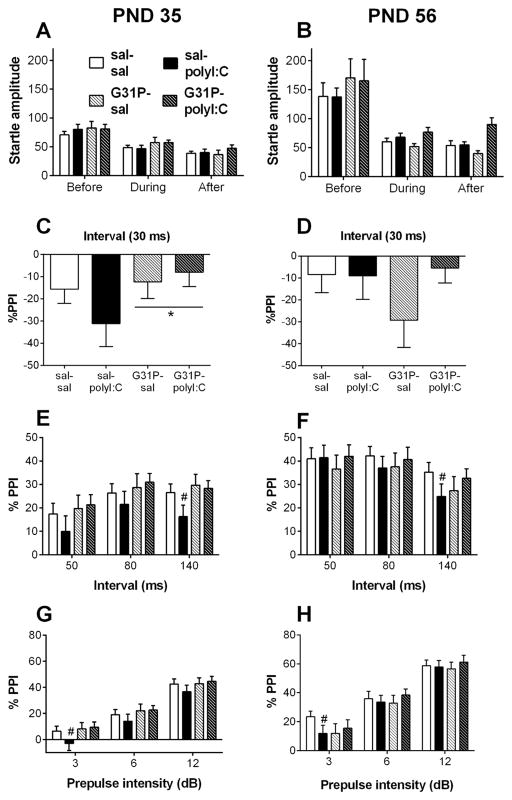Fig. 3.
Acoustic startle responses and prepulse inhibition (PPI) of the offspring following maternal polyI:C and G31P treatment. A, B. Acoustic startle responses (startle amplitude, arbitrary units) for 120 dB pulse trials before, during, and after the PPI trials at postnatal days (PNDs) 35 (A) and 56 (B) (sal–sal, n = 27; sal–polyI:C, n = 21; G31P–sal, n = 21; and G31P–polyI:C, n = 23). C, D. % PPI for trials with a 30 ms prepulse–pulse interval at PNDs 35 (C) and 56 (D). Data are averaged for the 3, 6, and 12 dB prepulse intensities. Negative % PPI values reflect an increase in startle to trials with a prepulse. G31P-exposed rats showed less prepulse facilitation than other rats (main effect of G31P). E, F. Percent PPI averaged by prepulse intensity for the 50, 80, and 140 ms prepulse–pulse intervals at PNDs 35 (E) and 56 (F). G, H. Percent PPI averaged by prepulse–pulse interval for 3, 6 and 12 dB prepulse intensities at PNDs 35 (G) and 56 (H). Group sizes for C, E, G: sal–sal (n = 24), sal–polyI:C (n = 20), G31P–sal (n = 21), and G31P–polyI:C (n = 22). Group sizes for D, F, H: sal–sal (n = 26), sal–polyI:C (n = 21), G31P–sal (n = 19), and G31P–polyI:C (n = 22). Number of litters included in testing: sal–sal (n = 15), sal–polyI:C (n = 11), G31P–sal (n = 11), and G31P–polyI:C (n = 12). # in panels F and H show the significant decreases in PPI for sal–polyI:C rats compared with sal–sal rats for trials with a 140 ms interval (F) and for trials with a 3 dB prepulse (H).

